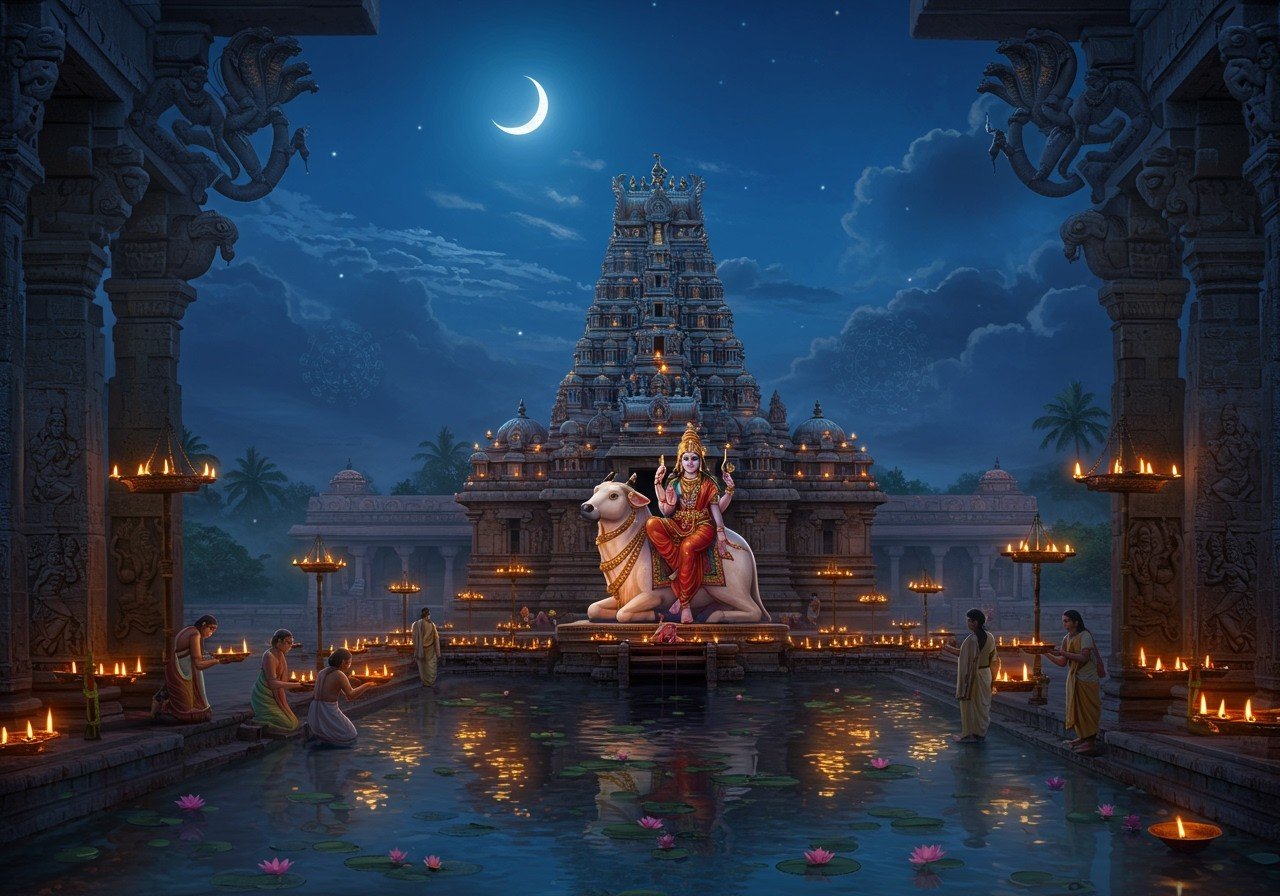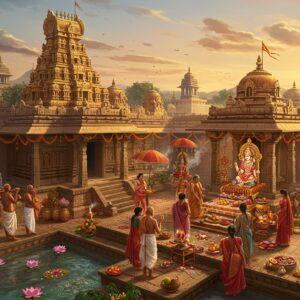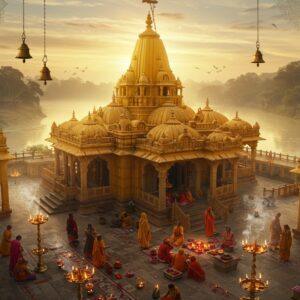
In Hindu tradition, Pradosha Puja stands out as a heartfelt ritual dedicated to Lord Shiva and Goddess Parvati. This sacred observance, held twice a month on the 13th day of the lunar cycle’s waxing and waning phases, takes place in Shiva temples across India, drawing devotees seeking blessings, spiritual solace, and a deeper connection with the divine. During Pradosha, temples transform into vibrant hubs of devotion, their architecture playing a crucial role in enhancing the Puja experience.
Pradosha is more than just a ritual; it’s a time of profound spiritual significance. It’s believed to be the time when Lord Shiva performed the Tandava, the cosmic dance of creation and destruction. This association with divine energy makes Pradosha an auspicious time for worship, and devotees believe that prayers offered during this period are especially potent. The specific rituals can vary across different regions and communities in India, showcasing the rich tapestry of spiritual practices within Hinduism. For a deeper understanding of temple rituals, explore our guide on the Somnath Temple rituals.
Key Architectural Elements in Shiva Temples
Certain architectural elements are common to most Shiva temples and contribute to the sacred atmosphere during Pradosha Puja. These include:
- Garbhagriha: This is the heart of the temple, the sanctum sanctorum where the main deity, often a Shiva Lingam, resides. It’s the most sacred space, symbolizing the divine presence.
- Mandapa: The mandapa is a pillared hall or pavilion leading to the Garbhagriha. It serves as a gathering place for devotees before they enter the inner sanctum. These halls are often ornately carved with intricate designs and depictions of deities and mythological scenes, adding to the temple’s artistic and spiritual richness.
- Shikhara: The towering spire above the sanctum, the Shikhara, is a prominent feature of temple architecture. It symbolizes the connection between the earthly and the divine, drawing the devotee’s gaze upwards towards the heavens.
- Nandi: Nandi, the sacred bull and Lord Shiva’s loyal mount, holds a special place in Shiva temples. The Nandi statue is typically positioned facing the Garbhagriha, signifying devotion and readiness to receive Shiva’s blessings. The placement and the surrounding space are particularly important during Pradosha Puja.
Learn more about architectural marvels in temples like Somnath.
Architectural Features Emphasized During Pradosha Puja
While all elements of a Shiva temple contribute to its spiritual ambiance, certain features are particularly relevant to Pradosha Puja:
- Nandi Mandapam: The area around the Nandi statue, often a dedicated mandapam, becomes a focal point during Pradosha. Devotees throng to this space, where special anointing rituals (abhishekam) are performed on Nandi, honoring Shiva’s faithful companion.
- Pradakshina Path: The circumambulation path, known as the Pradakshina Path, is an essential part of temple worship. Some temples have a specific Pradosha Pradakshinam. For instance, the Somasooktha Pradakshinam involves a unique circumambulation pattern forming a crescent moon shape around the Nandi, adding a symbolic layer to the ritual. Explore the principles of Hindu sacred architecture for a deeper understanding.
- Gopurams: These towering gateway structures, characteristic of Dravidian architecture, mark the temple entrance. Adorned with elaborate carvings and sculptures of deities and scenes from Hindu mythology, they create a grand and awe-inspiring welcome for devotees.
- Panchayatana Style: Some temples, like the Prachin Panch Ratna Temple, follow the Panchayatana style, featuring four subsidiary shrines dedicated to other deities surrounding the main Shiva shrine. This architectural arrangement emphasizes the interconnectedness of the divine pantheon.
Notable Temples for Pradosha Puja
Several temples across India are renowned for their Pradosha Puja celebrations. Each has unique architectural features that enhance the spiritual experience:
- Pallikondeswara Temple (Pradosha Kshetram): This temple is unique for its depiction of Lord Shiva in a reclining pose with Goddess Parvati. Its Dravidian architecture, with towering gopurams and ornate mandapams, creates a majestic backdrop for the Pradosha rituals.
- Brihadeeswarar Temple (Thanjavur): The Nandi mandapam in this grand temple becomes a hub of activity during Pradosha, filled with devotees seeking blessings. Long queues form for a glimpse of the main deity within the Garbhagriha.
- Perumparamba Sri Mahadeva Temple: One of the 108 Shiva temples in India, this temple’s architecture is steeped in legends and myths, adding a layer of cultural richness to the spiritual atmosphere. Delve deeper into the stories behind these temples with our collection of holy books.
- Tali Mahadeva Temple: Known for its intricate granite sculptures and carvings, this ancient temple captivates visitors with its artistic beauty and spiritual serenity.
Poojn.in: Your Companion for Pradosha Puja
At poojn.in, we understand the importance of having authentic and readily available puja samagri for your Pradosha observances. We offer a wide range of products delivered right to your doorstep, including:
- Complete Puja Kits: Find everything you need for Pradosha Puja in our curated kits, ensuring a convenient and complete worship experience. Explore our Puja kits here.
- Sacred Items: From pure copper snake idols to traditional bilva leaves and garlands, we offer a variety of sacred items to enhance your Puja. Find authentic puja items like clay ghots.
- High-Quality Incense and Lamps: Enhance the ambiance of your puja with our premium dhoop and deep items. Explore our range of flammables.
- Silver & Brass Items: Elevate your puja with pure silver and brass items that add a touch of traditional elegance. Discover traditional items like sindur dibbi.
Visit poojn.in today to explore our complete collection or contact us via phone at 03369029784 or WhatsApp at 9476142738. We offer pan-India delivery and dedicated customer support to help you find the perfect items for your Pradosha Puja.
Conclusion: A Timeless Tradition
Pradosha Puja, a deeply rooted tradition in Hindu culture, beautifully intertwines devotion with architectural splendor. Temples, designed with thoughtful consideration for the rituals and the spiritual needs of devotees, become sacred spaces where individuals connect with the divine. The architectural elements, from the sanctum sanctorum to the towering gopurams, all play a part in creating a harmonious and uplifting environment for worship.
As devotees gather for Pradosha Puja, they experience a profound sense of community and shared spirituality. The presence of Nandi, the resonating chants, and the symbolic circumambulation all contribute to a deeply moving experience. Through its architectural brilliance and the heartfelt devotion of its participants, Pradosha Puja continues to thrive as a cherished tradition, passed down through generations, enriching lives and connecting people to their spiritual heritage. Explore our Diwali Puja guide for more insights into Hindu rituals.


